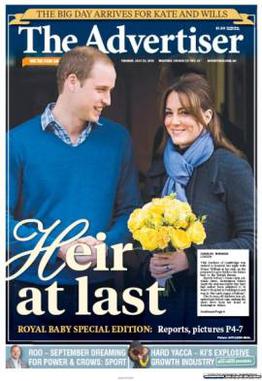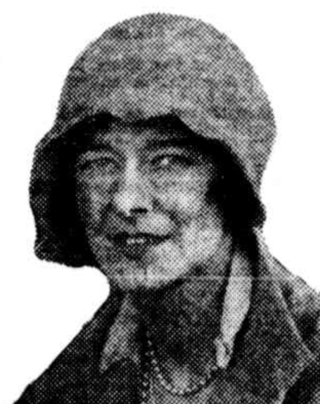Related Research Articles
The News was an afternoon daily tabloid newspaper in the city of Adelaide, South Australia, that had its origins in 1869, and ceased circulation in 1992. Through much of the 20th century, The Advertiser was Adelaide's morning broadsheet, The News the afternoon tabloid, with The Sunday Mail covering weekend sport, and Messenger Newspapers community news.

Port Pirie is a small city on the east coast of the Spencer Gulf in South Australia, 223 km (139 mi) north of the state capital, Adelaide. Port Pirie is the largest city and the main retail centre of the Mid North region of South Australia. The city has an expansive history which dates back to 1845. Port Pirie was the first proclaimed regional city in South Australia, and is currently the second most important and second busiest port in SA.

The Advertiser is a daily tabloid format newspaper based in the city of Adelaide, South Australia. First published as a broadsheet named The South Australian Advertiser on 12 July 1858, it is currently a tabloid printed from Monday to Saturday. The Advertiser came under the ownership of Keith Murdoch in the 1950s, and the full ownership of Rupert Murdoch in 1987. It is a publication of Advertiser Newspapers Pty Ltd (ADV), a subsidiary of News Corp Australia, itself a subsidiary of News Corp. Through much of the 20th century, The Advertiser was Adelaide's morning broadsheet, The News the afternoon tabloid, with The Sunday Mail covering weekend sport, and Messenger Newspapers community news. The head office was relocated from a former premises in King William Street, to a new News Corp office complex, known as Keith Murdoch House at 31 Waymouth Street.
The Round Australia Trial was a long distance rally, which was run on multiple occasions between 1953 and 1998, circumnavigating Australia. Its early years were tremendously popular as the roads through large portions of the country, particularly west of Adelaide, were not in good condition. Automobile manufacturers enthused over the event as it provided a particularly severe test event for their products, proving their cars were able to stand up to whatever conditions remote Australia could provide. Early editions of the event were heroic tests and were front-page fodder for the newspapers of the era.
The Recorder is a newspaper published in Port Pirie, South Australia since 1885. Formed by an amalgamation in 1898, it was also previously known as Port Pirie Recorder and North Western Mail between 1898 and 1918, and as The Recorder from 1919. It was later sold to Rural Press, previously owned by Fairfax Media, but now an Australian media company trading as Australian Community Media.
The Herald was a weekly trade union magazine published in Adelaide, South Australia between 1894 and March 1910; for the first four years titled The Weekly Herald. It was succeeded by The Daily Herald, which ran from 7 March 1910 to 16 June 1924.

The Bunyip is a weekly newspaper, first printed on 5 September 1863, and originally published and printed in Gawler, South Australia. Its distribution area includes the Gawler, Barossa, Light, Playford, and Adelaide Plains areas. Along with The Murray Pioneer, The River News, and The Loxton News,The Bunyip was now owned by the Taylor Group of Newspapers and printed in Renmark.

The Sydney Sportsman was a horse racing and sporting newspaper published in Sydney, Australia from 1900 to 1960. It continues to be published as The Sportsman.
Quiz was a weekly newspaper published in Adelaide, South Australia from 1889 to 1910. Between 1890 and 1900 it was known as Quiz and The Lantern.
Alfred Thomas "Alf" Chandler was a journalist, editor and newspaper proprietor in Victoria, South Australia and Western Australia. He was prominent in the Western Australian secession movement.
The District Council of Pirie was a local government area in South Australia from 1892 to 1996. It surrounded, but did not include, the city of Port Pirie, which had its own municipal government as the City of Port Pirie.
The Sport was a newspaper published in Adelaide between April 1911 and October 1948, which apart from articles on racing, football, cricket, and boxing, carried items of general interest, satire and political comment.
Thomas Henry Jones Mus. Bac. was a South Australian organist and music teacher.
The Australische Zeitung was a weekly German-language newspaper published in Tanunda, South Australia from 1860 until it ceased publication during World War I in 1916 due to anti-German sentiment. The newspaper also existed in a variety of earlier names or merged publications, reflecting the fluid nature of the newspaper industry in Victorian gold rush era colonial South Australia. The long history of German language Australian newspapers reflects the considerable German-speaking population which settled in South Australia in the nineteenth century.

Patricia Hackett was an Australian heiress, lawyer, actress and author, remembered today in the Patricia Hackett Award for writing.
The Leader is a weekly newspaper first published in Angaston, South Australia on 24 July 1918, and continues to the present day to be published in the Barossa Valley. It was the first English-language newspaper covering any part of the Barossa Valley, apart from the Kapunda Herald.
The Telegraph was a newspaper in Adelaide, South Australia, founded in 1862, and merged with The Express to become The Express and Telegraph, published from 1867 to 1922.
William Bowen Chinner was a South Australian organist, choirmaster, teacher and composer.
Frederick Harvie Linklater was an English barrister who had a prominent career in Australia. He was the author of several important legal works and popular stage plays. He was personally involved in a bigamous marriage and two libel cases, then was accused of master-minding an insurance fraud. He changed legal jurisdictions several times in what appears to be attempts to start afresh.
Ozone Theatres Ltd, formerly Ozone Amusements, was a cinema chain based in Adelaide, South Australia, from 1911 until 1951, when it sold its theatres to Hoyts. It was founded by Hugh Waterman and was jointly run by him and seven sons, including Clyde Waterman and Sir Ewen McIntyre Waterman. S.A. Theatres and Ozone Theatres were subsidiary companies, and the chain was referred to as the Ozone circuit.
References
- ↑ "General News". The Southern Cross . Vol. II, no. 60. South Australia. 22 August 1890. p. 7. Retrieved 10 June 2016– via National Library of Australia.
- ↑ "Spirit of the Press". The Mount Barker Courier and Onkaparinga and Gumeracha Advertiser . Vol. 11, no. 537. South Australia. 16 January 1891. p. 3. Retrieved 11 June 2016– via National Library of Australia.
- ↑ "Personal Reminiscences". The Recorder . No. 11, 741. South Australia. 21 November 1936. p. 3. Retrieved 10 June 2016– via National Library of Australia.
- ↑ "A Libel Case". The Express and Telegraph . Vol. XXXVIII, no. 11, 146. South Australia. 7 December 1900. p. 2. Retrieved 10 June 2016– via National Library of Australia.
- ↑ "The Libel Case". The Advertiser . Vol. XLIII, no. 13, 314. Adelaide, South Australia. 20 June 1901. p. 8. Retrieved 10 June 2016– via National Library of Australia.
- ↑ "Alleged Trespass". The Advertiser . Vol. XLIX, no. 15, 055. Adelaide, South Australia. 18 January 1907. p. 7. Retrieved 10 June 2016– via National Library of Australia.
- ↑ "The Press Gang". Gadfly . Vol. III, no. 122. South Australia. 10 June 1908. p. 7. Retrieved 11 June 2016– via National Library of Australia.
- ↑ "Alleged Unnatural Crime". The Sport . Vol. V, no. 52. South Australia. 11 June 1915. p. 2. Retrieved 11 June 2016– via National Library of Australia.
- 1 2 3 4 "SA Memory: Adelaide Truth". State Library of SA. Retrieved 10 June 2016.
- ↑ "Personal Reminiscences". The Recorder . No. 11, 741. South Australia. 21 November 1936. p. 3. Retrieved 11 June 2016– via National Library of Australia.